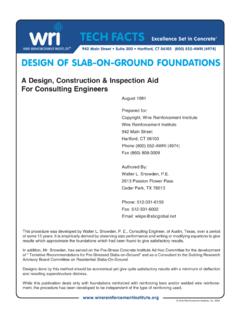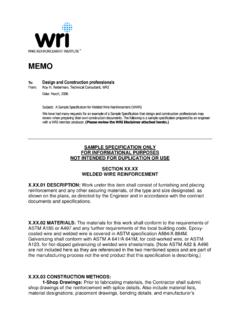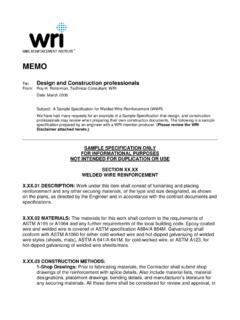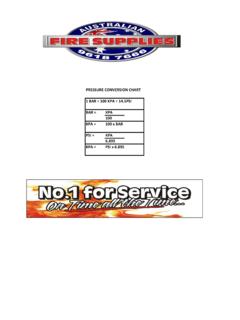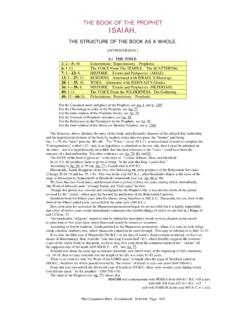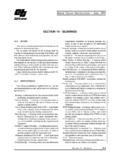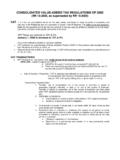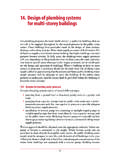Transcription of Historical Data on Wire, Triangular Wire Fabric/ …
1 Excellence Set in Concrete Page 1 wire Reinforcement Institute, Inc. TF 101-Intro- 14 historical data on wire , Triangular wire fabric / Mesh and Welded wire Concrete Reinforcement Introduction To: Architects, Structural Engineers, Contractors and Building Owners We receive many technical inquiries on old wire spacings, wire sizes and descriptions. Also, many ask what the physical /mechanical properties are for wire (See ). The reprint of old ASTM Standards and the three tables that follow provide answers to a number of questions often posed. For example, what is the tensile strength and yield strength of the old wire and WWR? The answer can be found on Page 1. On Page 2 can be found the table of gage numbers and the diameters, areas and weights of wires from 16 gage to 1/2 inch wires. Page 3 is addressed to Triangular mesh (before welded wire came on the scene) the table gives style numbers with single wire or bundled wires that yield the areas of the longitudinal wires (the main or structural wires).
2 Weights per 100 square feet are also included on Page 3. Triangular wire mesh was only made with longitudinal wires. Diagonal wires were used at 2, 4 or 8 inches to hold the longitudinal wires in place. If one desired to have the same wires in the transverse direction (for two-way reinforced slabs) another sheet was made and placed on top of the other sheet at 90 degrees. Page 4 contains typical tables of wire properties similar to the way WWR is described today however, in those tables gages were used and not areas of wire . Those styles were used from 1915 through the 1960 s. These four pages should answer most questions about old wire and the various styles of WWR or mesh used in the past. It is always a good idea to take a sample of the wire reinforced concrete to check or confirm what wire sizes and spacings were used and where it was placed in the concrete. Many times field changes were made and material that was specified or shown on the plans may have been changed in the field.
3 Pages 5-7 tell the story of the history of WWR, followed by a conclusion page, titled This Modern Era - describing where the industry is today. Excellence Set in Concrete Page 2 wire Reinforcement Institute, Inc. TF 101-Intro-14 Physical Properties and Tests PHYSICAL PROPERTIES AND TESTS TENSION TESTS 4 (a) The wire , except as specifed in Paragraphs (b) and(d), shall conform to the following minimum requirementsas to tensile properties: Tensile strength, lb. per sq. in.. 80,000 Yield point, lb. per sq. in.. Tensile strengthReduction of area, percent .. 30 (b) For wire to be used in the fabrication of mesh aminimum tensile strength of 70,000 lb. per sq., be shall bepermitted. Reprinted, with permission, from A82-34, Standard Specifications for Cold-Drawn Steel wire for wire for Concrete Reinforcement and A 185-37, Standard Specifications for Welded Steel wire fabric for Concrete Reinforcement, copyright ASTM International, 100 Barr Harbor Drive, West Conshohocken, PA 19428 Excellence Set in Concrete Page 3 wire Reinforcement Institute, Inc.
4 TF 101-Intro-14 Old Gage Numbers with Diameters, Areas of Steel and Weights Steel wire Gage Numbers wire Weight Pounds Per Foot Diameter Inches Area Square Inches .5000 .19635 .6668 0000000 .4900 .18857 .6404 000000 .4615 .16728 .5681 00000 .4305 .14556 .4948 0000 .3938 .12180 .4136 000 .3625 .10321 .3505 00 .3310 .086049 .2922 0 .3065 .073782 .2506 1 .2830 .062902 .2136 2 .2625 .054119 .1838 .2500 .049087 .1667 3 .2437 .046645 .1584 4 .2253 .039867 .1354 5 .2070 .033654 .1143 6 .1920 .028953 .09832 7 .1770 .024606 .08356 8 .1620 .020612 .07000 9 .1483 .017273 .05866 10 .1350 .014314 .04861 11 .1250 .011404 .03873 12 .1055 .0087417 .02969 13 .0915 .0065755 .02233 14 .0800 .0050266 .01707 15 .0720 .0040715 .01383 16 .0625 .0030680 .01042 Excellence Set in Concrete Page 4 wire Reinforcement Institute, Inc. TF 101-Intro-14 Description of Triangle Mesh Reinforcement TRIANGLE MESH WOVEN wire REINFORCEMENT is made from cold drawn mild steel having a high breaking strength, the longitudinal or tension members are spaced 4 inches, the diagonal cross wires either 2, 4 or 8 inches.
5 For the light styles of fabric the one wire , for the medium styles two styles three wires stranded. The size TRIANGLE MESH REINFORCEMENT is regularly made in standard rolls but can be furnished straightened and cut to lengths when required providing the tonnage is of sufficient amount. As a general rule roll material can be more easily handled and installed in the work and should be preferred by the user. Triangular wire Mesh Reinforcement 1901-1910 s The red circle on the example call-out is defined: Style 245 (the area of steel per foot of concrete cross section). The 2 wires were bundled together (2- No. 4 gage @ 4 spacings = square inches per foot of concrete cross section). The weight as we show it today (# per 100 square feet of wire sheet or roll). Note the column that is headed Sectional Area means that the cross section is allowed in ASTM Standard A82 to be a minimum area as noted in that column titled Sectional Areas. Style Number Number and Gage of Wires each Longitudinal American Steel & wire Company s Steel wire Gage Sectional Area Longitudinals square inches per foot width Total Effective Longitudinal Sectional Area square inches per foot width Approximate Weight lbs.
6 Per 100 square feet 032 1 - No. 12 gage .026 .032 22 040 1 - 11 .034 .040 25 049 1 - 10 .043 .049 28 058 1 - 9 .052 .058 32 068 1 - 8 .062 .068 35 080 1 - 7 .074 .080 40 093 1 - 6 .087 .093 45 107 1 - 5 .101 .107 50 126 1 - 4 .120 .126 57 146 1 - 3 .140 .146 65 153 1 - inch .147 .153 68 168 1 - No. 2 gage .162 .168 74 180 2 - 6 .174 .180 78 208 2 - 5 .202 .208 89 245 2 - 4 .239 .245 103 267 3 - 6 .261 .267 111 287 3 - 5 .281 .287 119 309 3 - 5 .303 .309 128 336 3 - 4 .330 .336 138 365 3 - 4 .359 .365 149 395 3 - 3 .395 .395 160 Excellence Set in Concrete Page 5 wire Reinforcement Institute, Inc. TF 101-Intro-14 WWR from 1915-1960 s Note in the red circle an example call-out is defined: Style 66-77 which is similar to the designation we use today the first two numbers are the spacing of longitudinal wires then the transverse wires (66 is 6 x 6 spacings) The next set of numbers is the wire gages (77 is 7ga.)
7 X 7ga.). See table of gages with properties. Note 7 gage wire has an area of square inches therefore 2 wires per foot = 0,049 square inches per foot of concrete cross-section. This is very similar to how we call out wire styles today with the exception that the gage numbers are now area numbers- which are multiplied by 100- Ex: a 7 gage wire has an area of Today we would put a W (for plain wire ) or D (deformed wire ) in front of the area multiplied by 100. The call out today would be 6x6-W or x W or STANDARD PAVEMENT STYLES OF AMERICAN WELDED wire fabric Showing Styles, Weights, Spacing and Gages of Wires and Sectional Areas. Style Weight of fabric Based on Net Width of 60 Inches Spacings of Wires in inches & W. Steel wire Gage Number Sectional Area in Square Inches per Foot of Width of fabric Lbs. per 100 Sq. Ft Lbs. per 100 Sq. Yd. Longitudinal Transverse Longitudinal Transverse Longitudinal Transverse 66-88 30 6 8 8 8.
8 041 .041 66-77 36 6 7 7 7 .049 .049 66-66 42 6 6 6 6 .058 .058 66-55 49 6 5 5 5 .067 .067 66-44 58 6 4 4 4 .080 .080 66-33 68 6 3 3 3 .093 .093 66-22 78 6 2 2 2 .108 .108 Description of American Electrically Welded fabric American Electrically Welded fabric is a square or rectangular mesh made from cold drawn steel wire electrically welded at the intersections of the transverse and longitudinal wires. Various combinations of spacings of wires can be furnished but the standard spacings for the longitudinals are 2, 3, 4 or 6 inches and transverse wires 8, 12, 16 inches. For economical reasons it is advisable to select from the styles on the following pages. The cross or transverse wires extend out one inch beyond the outside or selvage longitudinal wires. The weights given in the following tables are based on a width of fabric measured to the center of the outside longitudinals. Square footage is also based on a width exclusive of the overhang of the cross wires outside of the longitudinals.
9 It is regularly made in rolls for fabric having number 3 gage or smaller longitudinal wires If the longitudinals are larger than number 3 gage, flat sheets only will be furnished. Any of the styles can be furnished straightened and cut to lengths at an advance in price over that for rolls All widths are based on the distance center to center of the outside or selvage longitudinal wires. The maximum width of fabric depends on the spacing of the longitudinal wires, as follows; 96 inch maximum for 4 or 6 inch spacing, 84 inch maximum for 3 inch spacing and 60 inch maximum for 2 inch spacing. American Electrically Welded fabric combines the same high quality of material and service that has given Triangle Mesh Reinforcement its enviable reputation. When imbedded in concrete this fabric yields the maximum of its steel strength.. Excellence Set in Concrete Page 6 wire Reinforcement Institute, Inc. TF 101-Intro-14 A Story on the History of wire and Welded wire for Concrete Reinforcement Over a hundred years ago in 1901, patent papers were fi led by Massachusetts inventor John Perry for a machine that was able to weld together wires in sheet form.
10 While his initial idea was to use welded wire sheets as fences, by 1906 catalogues were advertising these sheets as reinforcement for concrete. In 1908, we saw the first major application of wire reinforcement in the construction of the Long Island Parkway. While it was only a lightweight mesh reinforcement weighing only lbs. per sq/ft, it represented a step forward. From 1908 until the start of World War I, many eastern states specified wire reinforcement in pavement, eventually increasing to weights of about lbs/sq ft. It is not clear when welded wire was first used with Portland Cement for concrete pavement. Between 1910 and 1915, stretches of pavement in DeKalb, Illinois, California and Forest Park, Maryland were poured using WWR. However, the DuPont Road in Delaware, also shares honors. The road was the forerunner of all superhighways and was built with a variety of reinforcing materials, including welded wire reinforcement. While it was built using specs that we know today are not conducive to long life, it was another major development in the viability of WWR.
